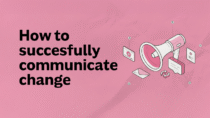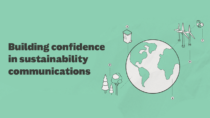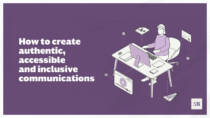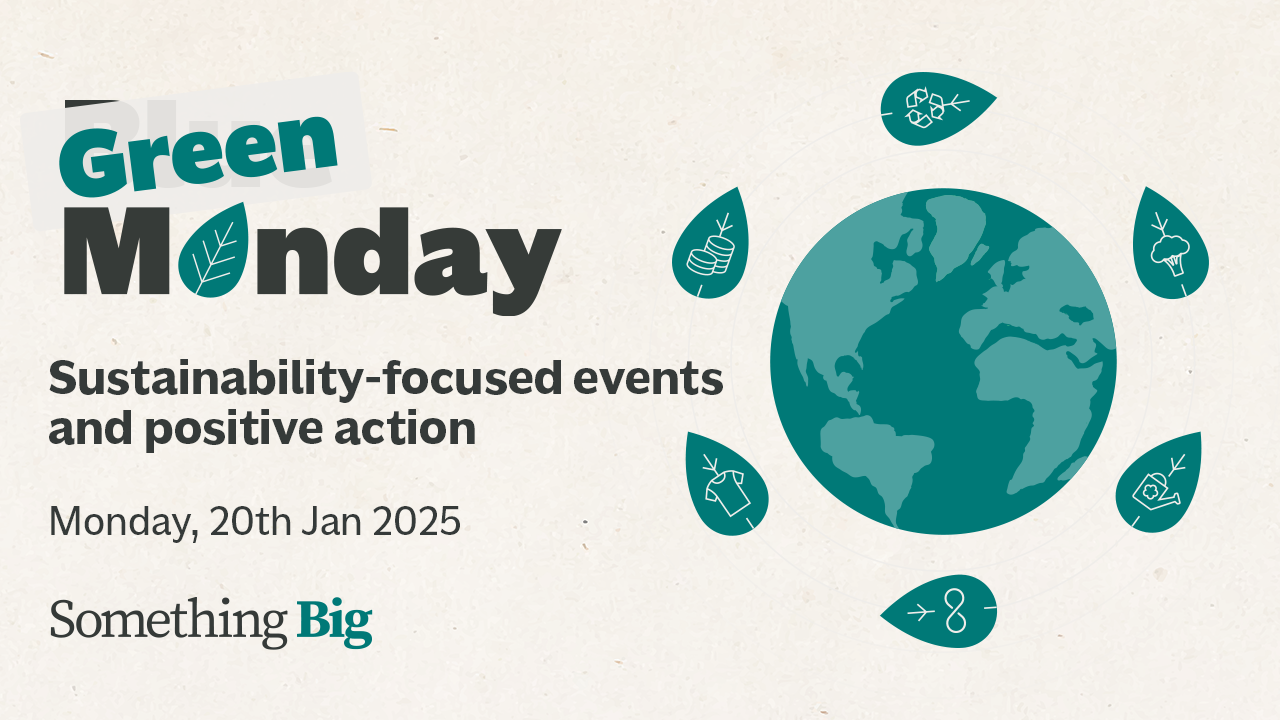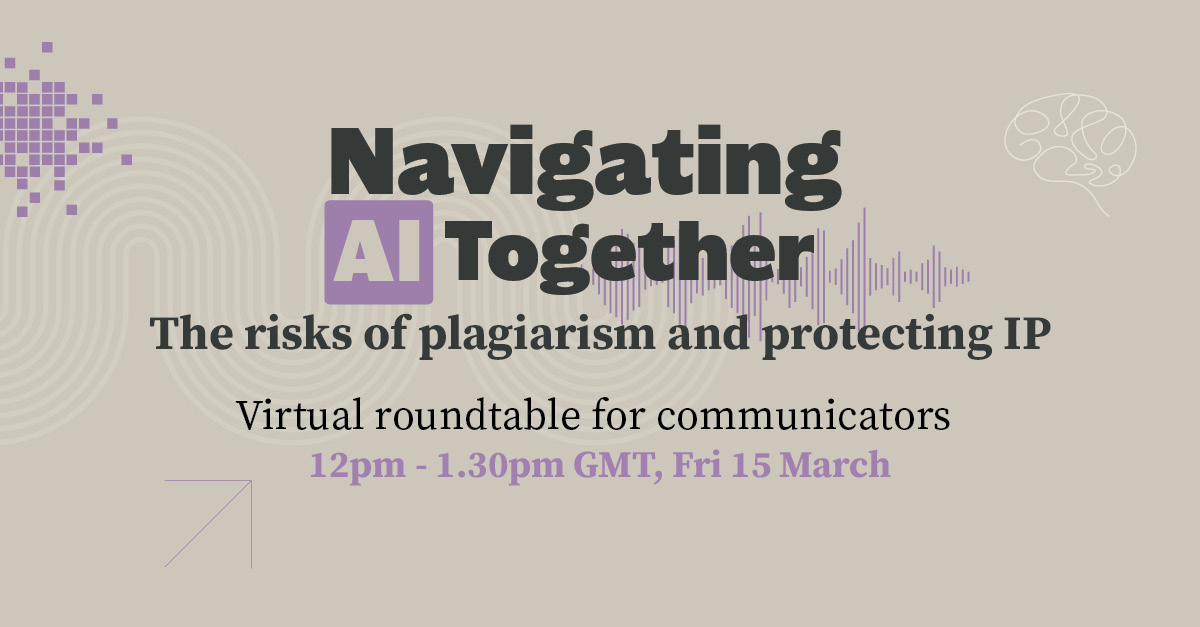Guide: How to Successfully Communicate Change
By Sally Pritchett
CEO
Your shortcut to change communications that build trust and make progress stick.
Change is hard. Around 70% of organisational change efforts fail – and poor communication is often one of the biggest cause. Employees are feeling overwhelmed, leaders are struggling to bring everyone on board, and transformation plans are stalling before they even get going.
If you’re looking for practical advice on how to communicate change effectively, this manual is for you.
Why change communications matter
Whether you’re navigating a restructure, embedding new technology, or rolling out a refreshed strategy, communication can make or break your change initiative. Successful change communication:
-
builds clarity and alignment
-
reassures and motivates people
-
keeps culture strong in times of uncertainty
-
drives real, lasting behaviour change
Inside the Big Change Communications Manual
Our free guide shares practical tools and proven techniques to help you lead change with confidence. You’ll discover how to:
-
Create the right environment for change by listening and setting clear goals
-
Use the right language and tone to build trust and reduce anxiety
-
Make complex change clear through storytelling and relatable examples
-
Keep change alive with a steady rhythm of updates and celebrations
-
Protect and evolve your culture so it carries people through uncertainty
Who is it for?
This manual is designed for leaders, HR teams and internal communications professionals who want to engage employees and make change stick. Whether you’re preparing for a major transformation or simply want to strengthen your day-to-day change communications, the insights will help.
Ready to make your next change a success? Download the Big Change Communications Manual and start building belief in your strategy.
Download here: How to successfully communicate change
We’ve created two accessible versions of the manual – light and dark mode – both optimised for screen readers. Choose the one that works best for you. Need help? Get in touch hello@somethingbig.co.uk.
PDF version
A PDF that can be read by a screen reader
Dark mode PDF
A PDF in dark mode, that can be read by a screen reader
Guide: How to support employee wellbeing with communication
By Sally Pritchett
CEO
Your shortcut to considered communication that supports employee wellbeing.
Whether it’s burnout, financial strain, chronic illness or mental health, the way we talk about wellbeing with employees makes a difference. The words we choose and the tone we set can either build trust – or come across as performative rather than supportive.
This guide is here to help. It offers practical advice for bringing a wellbeing lens to your communication so your messages feel thoughtful and rooted in care.
What’s inside:
-
Why poor communication can undermine wellbeing – even with good intentions
-
How to avoid overpromising, assumptions and unhelpful tone
-
Tips for writing with clarity, empathy and inclusivity
-
Language swaps that reduce stigma and help people feel seen
-
Advice for managers having sensitive conversations
-
Real-world examples to learn from
Who it’s for:
This guide is for anyone working in internal comms, HR, DEI or wellbeing – especially if you’re looking to strengthen your messaging, embed wellbeing into the everyday.
Download here: How to support employee wellbeing with communication
Download your screen reader–friendly guide below. Need help? Get in touch: hello@somethingbig.co.uk
PDF version
A PDF that can be read by a screen reader
Guide: Building confidence in sustainability communications
By Sally Pritchett
CEO
Your shortcut to confident, compelling and trustworthy sustainability comms.
Sustainability comms is one of the hardest things to get right.
Say too little, and people won’t know about all the great work you’re doing. Say too much, and you could risk being accused of greenwashing. The stakes are high, but the opportunity is huge – when you get it right, you build trust, inspire action and create real change.
This guide is here to help you do exactly that.
Whether you’re a communications professional tasked with telling the sustainability story – or a sustainability lead trying to get people to listen – this practical manual is designed to help you communicate with clarity, honesty and impact.
What’s inside:
- Why sustainability comms is uniquely challenging – and how to overcome the common traps
- How to communicate honestly without greenwashing – or greenhushing
- Tips for choosing the right words, tone and visuals
- Insights on how different generations engage with the topic of sustainability
- Real-world examples, do’s and don’ts and easy wins you can start using right away
- Cut through the noise. Say what matters. And say it in a way people trust.
Download the manual and start building confidence in your sustainability comms.
Download here
We’ve created two accessible versions of the manual – light and dark mode – both optimised for screen readers. Choose the one that works best for you. Need help? Just drop us a line at hello@somethingbig.co.uk.
PDF version
A PDF that can be read by a screen reader
Dark mode PDF
A PDF in dark mode, that can be read by a screen reader
Guide: How to create authentic, accessible and inclusive communications
By Sally Pritchett
CEO
Discover how to create communications that connect with audiences through authentic, accessible, and inclusive messaging in this essential guide.
Inclusive, accessible, and authentic communication has the power to connect, inspire, and drive meaningful change. This manual, How to Create Authentic, Accessible, and Inclusive Communications, is an essential resource for anyone striving to create messaging that resonates with diverse audiences and delivers real impact.
Packed with insights, guidance, and actionable tips, this guide will help you ensure your work is inclusive, accessible, and authentically representative. Whether you’re looking to deepen your understanding, refine your communication approach, or start embedding inclusion into your processes, this manual provides the tools and inspiration you need.
In this manual you’ll discover:
- Why inclusivity in communications matters and how it drives connection and impact.
- What inclusive communications should look and feel like with practical examples.
- How to foster diversity and authentic representation while avoiding tokenism.
- Practical tips for accessibility making sure your communications reach everyone.
- Advice on using AI ethically to support inclusivity and authenticity.
- How to build an inclusive mindset and embrace continuous improvement
Download the guide now and start creating communications that inspire change, connect with audiences, and make a lasting difference.
Choose the right version for you
We’ve created several versions of the manual, each with different accessibility features. Please choose the option that works best for you. If you need assistance navigating these options, don’t hesitate to get in touch with us hello@somethingbig.co.uk.
PDF version
A PDF that can be read out by a screen reader
Dark mode PDF
A PDF in dark mode, that can be read out by a screen reader
Audio PDF
A PDF with the option to be read aloud by an AI voiceover
Video audio
A video of the manual, read by an AI voiceover
2025 Workforce Trends Every Communicator Needs to Know
By Sally Pritchett
CEO
What does 2025 have in store for the workplace - and how can effective, inclusive communication help navigate the challenges ahead?
What does 2025 have in store for the workplace - and how can effective, inclusive communication help navigate the challenges ahead?
We’ve reviewed insights from leading organisations, including Great Place to Work, Top Employer, Make Work Better, Gallup, Mercer, and more. We’ve identified the six key trends shaping workplace culture, and how communicators can play a pivotal role in supporting these trends.
1. Changing workforce demographics
As the workforce spans more generations than ever, the growing generational gap could lead to intergenerational tensions.
How communicators can help:
Earlier in the year we explored the communications challenges that can cause friction between different generations. Check out our practical guides on unravelling ageism, improving collaboration between generations, shifts in language, channels and communications format and hear from experts on how the multigenerational workforce can be united.
2. Creating Neuroinclusive workplaces
With greater awareness of neurodiversity, organisations are recognising the value of different ways of thinking. To unlock this potential, workplaces need to become more neuroinclusive.
How communicators can help:
Explore how to create neuroinclusive work environments or sign up to this event on the 10 January with Autism Unlimited, to learn practical steps and strategies to foster a neuroinclusive workplace culture.
3. Adapting to evolving technology
While technology promises greater efficiency, it also risks overwhelming employees if not managed carefully. Adding new communication channels without retiring outdated ones can lead to digital overload.
How communicators can help:
Discover how to identify and address communication overload in your organisation. Read this article for practical fixes and insights into improving digital body language for more meaningful, productive interactions.
4. Focusing on sustainability and ESG
The climate crisis demands urgent action, and organisations need to actively engage employees in their sustainability and ESG efforts. There’s no room for “climate fatigue.”
How communicators can help:
In this research, we discovered how different generations talk about climate and sustainability so that we engage employees and create a culture of sustainability.
To carry on the conversation in 2025, join our Green Monday sessions to hear from sustainability and comms leaders on how they are engaging their communities.
5. Strengthening belonging and inclusion
Everyone deserves to feel safe, included, and free to be themselves at work. Accessibility plays a vital role in creating an inclusive environment where everyone can fully engage and contribute.
While progress in DEIB (Diversity, Equity, Inclusion, and Belonging) has accelerated, there’s still much work to do – especially as rising workplace loneliness highlights the gaps in creating truly connected and supportive cultures. Accessible communication can help to ensure no one is left out, fostering a sense of belonging that goes beyond physical and digital barriers.
How communicators can help:
For communications to be impactful and inclusive, they must also be accessible. Give everyone the same access to your comms with our practical advice on levelling up accessibility in your communications
6. Prioritising health & Wellbeing
Declining employee wellbeing continues to raise alarm bells – from burnout and mental health challenges to rising cancer rates and reduced physical activity.
How communicators can help:
Take the first step in building a culture of wellbeing. Read our guide for practical strategies, or explore how to support employees living with cancer.
As we approach 2025, fostering a workplace culture that is healthy, safe, and inclusive has never been more critical. If you’re looking for expert support to develop internal communications strategies that engage and empower your workforce, we’re here to help.
The emotional rollercoaster of work: insights from Gallup’s 2024 Report
By Sally Pritchett
CEO
We explore the latest Gallup State of the Global Workplace report to uncover key insights and their implications for the workforce.
Imagine this: over a quarter of the UK workforce experiences sadness for a significant part of their workday. Yes, you read that right. The UK is second highest in the world when it comes to workplace-induced sadness. And on top of that, stress levels remain alarmingly high with 38% of employees reporting high stress and almost 1 in 5 experiencing frequent anger.
Our jobs, which should ideally bring purpose and satisfaction, are casting shadows over our daily lives. Clearly work can evoke strong emotions in employees and for many, it’s negative.
These shocking insights comes from the Gallup State of the Global Workplace 2024 report, covering data from 100 different countries across the world.
We take a deeper look into the numbers to see what’s really going on behind those office doors and on the factory floors.
Key insights from the Gallup Report: engagement or disengagement?
The first notable finding in the report is the level of engagement. Unfortunately, here in the UK engagement remains low at 10%. But there’s a twist – management plays a crucial role in this statistic.
Why managers matter
Gallup’s findings highlight that managers are pivotal, accounting for 70% of the variance in team engagement. So, if employees are feeling disconnected at work, managers may well have a lot to do with it.
Here are some insights from the report:
- Loneliness at work: 20% of the world’s employees experience daily loneliness, with young employees feeling it more acutely. Interestingly, having a job generally decreases loneliness – 20% of working adults feel lonely compared to 32% of those unemployed.
- The manager’s dilemma: Whilst managers are more likely to be engaged and thriving in life, feeling their opinions count and having a strong connection to their organisation and colleagues, their emotions are a rollercoaster. They experience higher highs and lower lows than non-managers, likely leaving them mentally exhausted.
- The flip side: However, the flip side is equally stark – managers are more prone to stress, anger, sadness, and loneliness. They’re also more likely to be on the lookout for a new job.
Challenges facing younger employees
The workplace environment for employees under 35 has significantly deteriorated, painting a challenging picture for the future workforce:
- Declining wellbeing: Wellbeing among younger employees declined in 2023.
- Loneliness epidemic: Younger workers under 35 are more likely to experience loneliness and less likely to feel cared about or have opportunities for development, especially in remote and hybrid settings.
- Lack of clarity: Less than 40% of young remote or hybrid employees know what is expected of them at work.
These stats are not just numbers; they reflect a growing discontent among younger employees that could have long-term implications for businesses if not addressed promptly.
Read more: How to effectively communicate with a multigenerational workforce
Strategies for improving workplace engagement and wellbeing
Managers play a pivotal role in shaping the employee experience. Countries with higher manager engagement see two times more engaged employees. When managers are engaged, their team members are more likely to be engaged too.
Disengaged employees cite the need for better culture. 41% of disengaged employees suggest that improving culture and engagement would enhance their workplace experience. And enhancing employee engagement can lead to significant improvements in business outcomes, retention and absenteeism, so it’s worth the investment.
Here are some practical takeaways for internal communicators to take forward:
- Support managers: Provide them with the tools and training they need to manage stress and build resilient teams. Encourage managers to have meaningful, two-way conversations with their team members.
- Develop clear communications: Clarity is key. Ensure that all employees, especially younger ones, understand their roles, what is expected of them and how their work aligns with the overall business purpose and goals.
- Openly support mental health and wellbeing: Provide resources and support for mental health. Creating an open and honest environment where employees feel cared for can improve overall wellbeing.
- Provide opportunities for connection: Encourage collaboration and interaction across all levels of the business to reduce feelings of isolation and loneliness. Build a sense of community through team-building activities and social events, even as virtual or hybrid events.
While the Gallup report paints a rather bleak picture of the current state of the global workplace, it also offers opportunities for the path forward. By focusing on engagement and supporting our managers, we can turn the tide and create a work environment that uplifts rather than brings down.
Are you ready to take a step forward to a more engaging and emotionally balanced workplace? Get in touch to discover how we can support you in creating a fairer, healthier, and happier workforce through the power of accessible and effective communications that drive real change.
Exploring fresh graphic design in creative communications
By Sally Pritchett
CEO
Explore the freshest trends in graphic design and find inspiration to create communications that connect with your audience.
As spring is blooming all around us, there’s no better time to infuse your creative communications with the spirit of renewal and growth. In this article we’re sharing what’s been inspiring us lately and examining some of the design trends we’re excited to see.
Sustainability and purpose-driven branding
Sustainable design is not a trendy, niche approach, it’s fast becoming a core principle. Consumers are looking for brands that align with their values and have a clear social or environmental mission. Brands that can effectively communicate their purpose and demonstrate their commitment to making a positive impact are likely to resonate. Customers are placing more value on products and services that prioritise sustainability, with studies finding that 81% of consumers believe brands should actively work to protect the environment.
From a design style perspective, we’re seeing a lot more thought go into packaging. Not just classic recyclable material and eco postage, but packaging being reusable or rethinking it by giving it a second life.
Sustainability conscious styling is starting to shift away from cliche ‘green’ to using a wider palette of nature through muted blues, beige and pinks to represent sustainability alongside the classic textured, earthy feel.
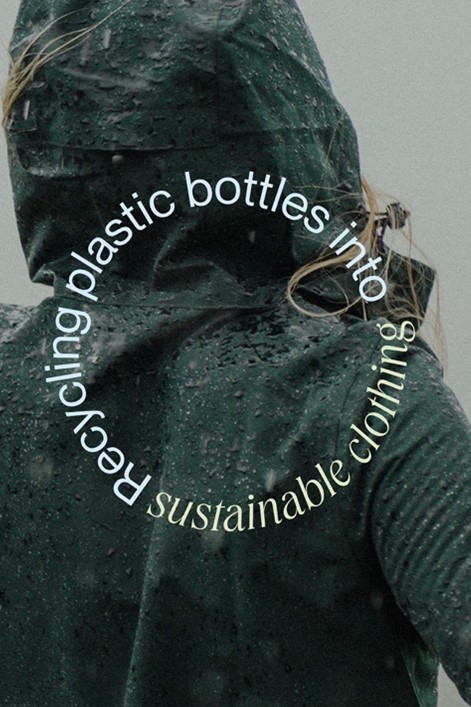 Amble Outdoors | Sustainable clothing
Amble Outdoors | Sustainable clothing
As well as seeing these visual changes, the messaging is diving deeper. As a more well-informed audience which has growing concern over climate change and other environmental issues, consumers are increasingly looking for brands that prioritise sustainability. Messages and campaigns are bold and calling people out when they’re greenwashing or contributing to negative sustainable practices, working towards a force for change.
Make My Money Matter | Oblivia Coal Mine
The continued rise of AI
AI has made a huge impact on the marketing world over the last year. While the creative industry may feel under pressure from generative AI tools, it has also never felt so full of potential and scope for growth. AI is streamlining the design process, providing insights and generating multiple styles quickly. And AI is not going anywhere! AI is only going to get bigger and better, especially as us as humans learn to control it and manipulate it.
In this recent survey by It’s Nice That, 83% of creatives in the industry are already using AI tools. There are still ethical concerns around bias – which still need a human eye to carefully consider outputs – and legal concerns around plagiarism but the technology will undoubtedly continue to improve.
 Midjourney outputs
Midjourney outputs
Embracing nostalgia
Fashion repeats itself every twenty years or so, and this holds true in design too. The content of nostalgia marketing changes with the generations, as each generation has different cultural references. Gen Z may look to cultural references from the ’90s or early ‘00s, whereas Gen X or older millennials might feel nostalgic about the ’80s and its cultural touchpoints.
We have seen a huge re-emergence of ’90s inspired designs stemming from the iconic Barbie and Mean Girls movies allowing many of us to embrace the childhood nostalgia. This is paving the way for vibrant colours, abstract shapes, funky patterns, and scrapbooking to name a few. These design styles create an emotional bond with the audience, this especially aligns with Gen Z’s growing digital fatigue and their desire for meaningful experiences and authenticity.
Cadburys | Yours for 200 years
Bold type
Sometimes text needs to do the talking. In a world where there is so much visual information thrown at us and video/social media can be so intrusive, a simple message is effective. More campaigns are using simple type to tell the message and make an impact. Simplicity is key. Clean imagery is being used but enhanced by the typography.
 B&Q | You can do it
B&Q | You can do it
Inclusive design
Inclusive design that is both diverse and accessible has rightly become a staple. Ranging from high-contrast graphics, clear typography, alt text for images, and diverse and inclusive messaging.
Inclusive design enables us to talk to global audiences, breaking down barriers and challenging stereotypes.
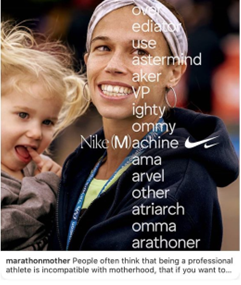 Nike | This athlete isn’t just an athlete she’s a mother too.
Nike | This athlete isn’t just an athlete she’s a mother too.
Impactful communications that connect with people
It’s clear that the world of graphic design is always changing and we’re seeing exciting trends shaping the way we communicate.
But amidst all this change, one thing stays the same: our commitment to making impactful designs that connect with people. Whether it’s telling your brand’s story or spreading a message, we’re here to help. If you’re looking to get cut through with your creative communications, reach out to us. Let’s work together to make something that makes a lasting impression.
Navigating AI together: the risks of plagiarism and protecting IP
By Sally Pritchett
CEO
In a thought-provoking session on AI, plagiarism and IP, we unravelled the challenges facing communicators using generative AI.
In our most recent ‘Navigating AI together’ session, we went on a journey to explore the legal challenges around the use of generative AI tools. We were delighted to be joined by Alex Collinson from Herrington Carmichael, a seasoned expert in commercial and intellectual property law.
The purpose of the ‘Navigating AI together’ series is to foster a community dedicated to responsible AI usage and to work through these challenges with clarity and integrity, together. In this recap of our discussion, we’re shining a light on the issues around AI and charting a path towards ethical and informed AI usage.
What do we mean by intellectual property, copyright and trademarks?
Many of us are likely guilty of using language like intellectual property, copyright and trademarks almost interchangeably. But to understand the legal landscape around AI, we need to get these terms nailed down.
- Intellectual property (IP): refers to creations of the mind, such as inventions, literary and artistic works, designs, symbols, names, and images used in commerce. IP is protected by laws which give the creators or owners exclusive rights to use their creations or discoveries for a certain period of time.
- Copyright: Copyright grants exclusive rights to creators of original works, such as books, music, and software, allowing them to control reproduction, distribution, and other uses for a limited time. Copyright acts as a deterrent to those who may wish to profit from reproduction, and can be licensed which can create a revenue stream for your business.
- Trademark: Trademarks protect words, symbols, or designs that distinguish goods or services, providing exclusive rights to their owners to prevent confusion among consumers and maintain brand identity.
Common copyright misconceptions
Even before we get into the new, complex and unclear realm of generative AI, Alex shared with us that there are a lot of common misconceptions:
- “Everything on the Internet is free to use”: Contrary to popular belief, just because something is freely available online doesn’t mean it’s in the public domain. Users must be cautious about where they obtain information and how they use it.
- “My name is protected by copyright”: Names and symbols can’t be protected by copyright; instead, they fall under trademark law. Trademarks prevent others from using similar names or symbols that could cause confusion in the marketplace.
- “You have to register your copyright to protect it”: Under English law, there’s no requirement to register copyright. Copyright protection automatically applies to works once they’re created, including artistic and literary works.
What the law says about generative AI
While the law is not quite up to speed with generative AI, Alex shared some interesting case examples to help us better understand the legal landscape.
Copyright
Alex shared with us a high-profile case, Getty Images (US) Inc v Stability AI Ltd [2023] EWHC 3090 (Ch), that highlights the difficulty generative AI is causing within copyright law. Getty Images alleged that Stability AI unlawfully scraped images from other websites to train its AI model, resulting in infringement of copyright and trademarks.
Despite Stability AI seeking summary judgment (without a full trial), the court refused, recognising the novel issues surrounding AI and copyright law. These legal nuances reveal the need for the law to adapt to the evolving landscape of AI technology, with more cases expected to emerge.
It is possible that copyright could be infringed when AI systems are trained, if this process involves copying a substantial part of copyright works that are still within the terms of protection. However, the issue regarding whether copying will be deemed to have occurred where a generative AI system has been trained on copyright works is not straightforward.
Potential issues include:
- Proving the use of copyrighted works in training AI: proving that copyrighted works were used to train and develop a generative AI system poses challenges due to the lack of transparency in data usage.
- Jurisdictional issues: determining the location of training and development activities, especially in cases involving online communication, can be complex. Although even if the activities occurred outside the UK but targeted the UK public, copyright law may still apply.
- Permitted acts under copyright law: Assessing whether any infringement occurred involves considering permitted acts outlined in the Copyrights Act. These acts include fair dealing defences, such as criticism, review, quotation, parody, caricature, and pastiche, which provide exceptions to copyright restrictions.
Trademarks
Given how new generative AI is and the evolving legal landscape, there are very limited case studies available. However, Alex explained how longer existing AI applications may help us to understand potential future legal implications.
AI-driven recommendation systems, commonly used in e-commerce, analyse user data to suggest products based on preferences and behaviour. Amazon, for instance, employs such AI technology.
In the case of Cosmetic Warriors and Lush v Amazon ([2014]EWHC 181 (Ch)), Amazon was found to have used Lush products and branding on its website to attract customers and recommend other products without Lush’s consent. Lush claimed trademark infringement, asserting that its intellectual property rights were violated, with the court ruling in its favour. This case highlights the importance of protecting trademarks within the digital marketplace.
The ethical dilemma
While the law hasn’t yet adapted to the emergence of generative AI, as communicators, we can’t afford to sit back and wait while these tools that can enhance creativity and productivity are available to us. With the ongoing legal uncertainties, it’s up to us to evaluate the ethical implications of our communications practices.
Consider a scenario shared during our session, involving Keith Haring’s artwork and an AI-generated copy produced on Midjourney, a licensed platform. Keith Haring is perhaps most famous for his art used in the iconic Change4Life public health campaign.
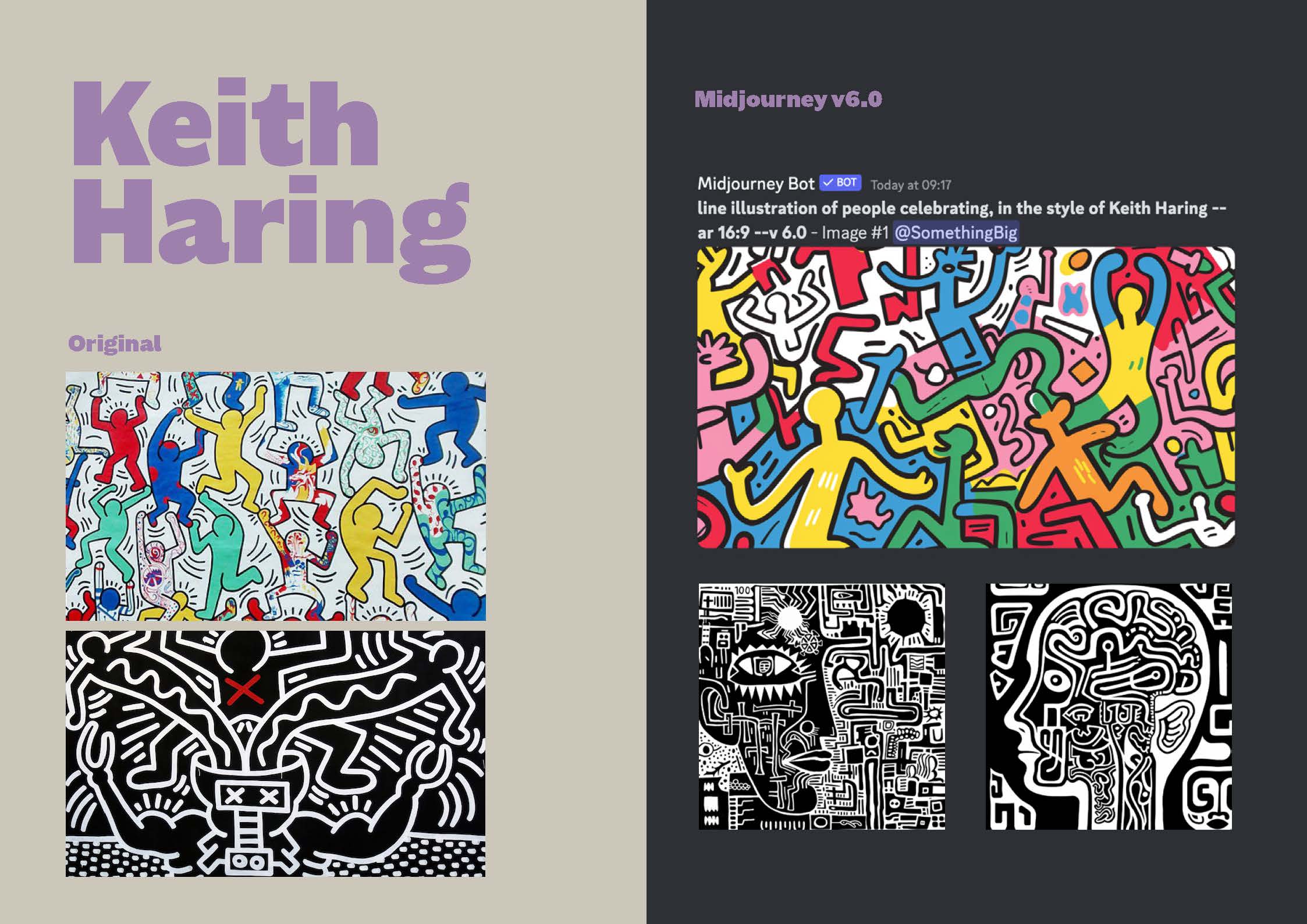
The Keith Haring Foundation, a charitable organisation dedicated to children in need and those affected by HIV/AIDS, holds the rights to Haring’s iconic artwork.
However, we posed a hypothetical situation where the government wants to commission a new public health campaign, once again using Haring’s renowned illustrative style. As our Midjourney example shows, instead of licensing art from the Keith Haring Foundation, they could potentially use AI-generated images.
This capability raises ethical and legal concerns regarding intellectual property rights. Despite the AI’s capability to mimic Haring’s style, using these images without consent from the Keith Haring Foundation could potentially infringe upon their IP rights. Not to mention the ethical impact of not licencing the images from a charitable foundation.
This example reflects the importance of ethics when incorporating AI-generated content into communication strategies, while we wait for the law to catch up.
We’d like to thank Alex for guiding us through this complex topic. If you’d like to explore the legal implications of generative AI further, we encourage you to connect with Alex on LinkedIn to stay updated on future discussions and insights.
Navigating AI together
Our upcoming session will delve into the role AI should play in marketing efforts and consider how marketers can best leverage AI to streamline tasks and free up valuable time.
If you’d like to be kept in the loop for details on this insightful discussion, get in touch.
4 steps to making generative AI an ally to inclusion
By Sally Pritchett
CEO
Discover four practical steps to mitigate bias in generative AI and ensure inclusive, authentic representation in your AI-powered communications.
AI offers amazing opportunities for communicators, from writing creative content to bringing to life a visual idea in a matter of seconds. But its power comes with a challenge: inherent biases.
Generative AI has been trained on human-created content, and so has inherited deep-seated bias built in. This bias can, and often does, unintentionally permeate AI-generated content, reinforcing stereotypes and misconceptions.
So as the human hands guiding AI, what can we do to help overcome these biases and use AI as a tool to foster inclusion and authentic representation?
1. Nurturing AI as responsible guides
It’s important that we hold the hand of AI and safely guide it as generative AI learns from the language we use. We need to ensure we understand the EDI landscape ourselves thoroughly first before we can expect AI to generate outputs that are genuinely inclusive and authentically representative.
2. Navigating our human bias
The second step to making AI an ally to inclusive communications is self-reflection. We’re human, and we’re fallible, and it is important to remember that in the context of EDI. As humans, we do form stereotypes – it’s a coping mechanism and our brain’s attempt to simplify the barrage of information we encounter daily.
We must remain vigilant – consciously slowing down and actively recognising these stereotypes within ourselves so we do not bring them into our communications with AI.
3. Increasing awareness of our unconscious biases
Unconscious bias refers to the automatic attitudes and stereotypes that influence our judgments and actions without our conscious awareness. Shaped by our experiences and societal influences, these biases impact how we view others.
If you’re considering using AI within your communications, then you must understand what your own unconscious biases are. The Harvard IATs – Implicit Association Tests – are a useful tool to help you begin to do this. Set up by a collaboration of US researchers in 1998, Project Implicit aims to collect data on our biases as we learn about ourselves. We’d recommended picking a test identity characteristic you think you don’t carry bias on and one you think you do – and see how it plays out. These tests can help you identify where your unconscious biases could influence AI.
4. Learning from our mistakes
AI is still a relatively new tool for many of us – we are still learning how to get the best out of ChatGPT or how to write an effective prompt on Midjourney. We are naturally going to make mistakes as we learn how to use different AI platforms. But we must learn from these and identify where we perhaps need to reword a prompt or change the language, we are using to generate more inclusive results. By taking our time to craft prompts carefully to guide unbiased outcomes we can minimise our mistakes and foster greater inclusion.
But what about if AI makes a mistake and leans on bias or stereotypes? We can help it learn from its mistakes too! By offering corrective feedback, we can help steer AI responses towards being more inclusive.
Navigating AI together
Our ‘Navigating AI together’ workshop series has been providing a safe and open space for communicators to discuss various aspects of AI.
This time, recognising the pressing need, we’re focusing on intellectual property and copyright issues. It’s an area that many communicators have been struggling to grapple with, so in our next session, on Friday 15th March, we’re going to delve into it together.
We are delighted to be welcoming Alex Collinson, from Herrington Carmichael, who specialises in commercial and intellectual property law matters. Alex will lead an insightful discussion covering copyright, brand protection, confidentiality concerns, and real-world cases of AI IP infringement.
Should your business start a podcast?
By Sally Pritchett
CEO
Discover how podcasts can help you engage your customers and employees.
In recent years, podcasts have continued to grow in popularity. In 2021, over 19.1 million people in the UK listened to podcasts, and this is predicted to grow to 28 million listeners by 2026. We’re also seeing people listening to podcasts on a regular basis – 25.5% of people say they listen to podcasts weekly.
Podcasts are becoming an effective communication channel for a whole host of businesses across different industries. Just like how we now consider social media a fundamental way to engage with our customers, marketers and comms professionals are starting to view podcasts in the same way. But podcasts aren’t just relevant for your customers or external audiences, they are a great way to increase engagement with the workforce too.
So how can you effectively leverage podcasts as a communications channel for your business?
Positioning your experts as thought leaders
One of this year’s trends in podcasting is the growing demand for educative content delivered in an entertaining and interesting way, as listeners want to stay informed and be inspired. Podcasts provide an opportunity for experts in your business to reach new audiences and share their knowledge, experience, and insights in an engaging way.
Connecting through real-time interaction
Another podcasting trend growing in popularity this year is live podcasting. Providing real-time engagement and a stronger connection with listeners, live podcasting provides an opportunity to deliver truly authentic content. Listeners have the opportunity to ask questions or guide the conversation in the way they want it to go and engage with speakers on a more personal level.
Exploring your brand personality
With podcasts typically having a more friendly and informal tone, they provide an opportunity for you to bring a more conversational element to your brand personality. Whilst listeners are looking to be entertained by podcasts, many are also keen to learn something new. This presents a real opportunity for businesses to provide informative and interesting content in a relatable and enjoyable way.
Communicating with employees
When communicating with employees, it can sometimes be difficult to break through the noise of day-to-day communications. Office-based employees constantly receive emails or instant messages, whilst frontline staff may be on the road or working in the warehouse where checking these channels might be more difficult. A podcast gives you the opportunity to engage employees through a different channel, perhaps whilst they are driving or commuting.
Giving employees a voice
Podcasts don’t just have to be a way to communicate with employees – they are a great opportunity to give employees a chance to talk about the things that matter to them. Whether you invite employees to be guest speakers or start an employee-led podcast series, this can be a great way to start conversations about important topics within your workforce.
Our top podcasting tips
- Release episodes regularly. People look forward to the next episode of their favourite podcasts being released – just like they would with the next episode of a TV series.
- Make sure your podcast is available on all the most popular platforms, such as Apple Podcasts and Spotify.
- Promote your podcast via your other channels. 32% of people hear about new podcasts through social media.
- Keep the tone conversational and friendly. Listeners typically find these types of podcasts relatable and enjoyable as they can feel like a conversation they would have themselves.
- Consider bringing in guest speakers who are relevant to the target audience.
If you’re looking for support in starting your podcasting journey, we’re here to help. From communications plans to recording podcast episodes, we can provide the support you need.

